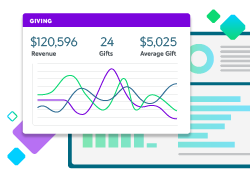Nonprofit Email Basics: Master Effective Fundraising Communications

If you feel a little unsteady about your nonprofit’s fundraising right now, you are not alone. Navigating a challenging economy, the rising cost of living, and staffing issues, many nonprofits are feeling the heat. But take heart.
“We’re not in unprecedented times,” said Shannon McCracken, CEO of The Nonprofit Alliance. “Fundraisers have been through real challenges before.”
A key tool in overcoming these challenges? Email marketing. With more than 4 billion users, email empowers you to reach a vast audience while targeting your messaging to particular constituents. Let’s dive into the basics of nonprofit emails so you can improve your fundraising results in any economy.
Your Priority: Engage Your Audience
Inboxes are flooded with more than 100 new emails a day. To make sure yours don’t get lumped in with the spam, here’s how to use your email communication to forge (or maintain) relationships with your constituents.
HAVE THEM AT HELLO
Start with an irresistible subject line that’s 50 characters or less and grabs your audience’s attention:
- Convey urgency. (“Our supply of pantry items will last only 30 days.”)
- Ask a question. (“How many Florida panthers still exist in the U.S.?”)
- Personalize it. (“Joe, join our new Art Lovers Speakers Series.”)
Follow up with compelling preview text (limited to 140 characters) that expands upon the subject line.
- Subject line: “How many Florida panthers still exist in the U.S.?”
- Preview text: “The number is smaller than you think. Discover the top 10 ways you can save endangered panthers.”
LEAVE THEM WANTING MORE
Keep the body of your email under 200 words and link to blog posts or videos for more information.
ADD VALUE
Value doesn’t have to be a giveaway or a freebie offer for donors, according to the Forbes Nonprofit Council, “but rather information that they can utilize on a daily basis to help benefit and stimulate their lives.” For example, link to a report that gives donors more information about a mission they’ve invested in, or profile a particular person or animal your organization helped last month.
CREATE AN EMAIL STRATEGY THAT WORKS
As with any strategy, begin with your desired outcome in mind, such as:
- Improving donor retention
- Reaching new constituents
- Fundraising for a particular project
- Improving brand recognition
- Increasing community engagement
- Communicating more effectively with donors
Next, create a multichannel strategy that harnesses the power of your website, social media, online giving software, direct mail, and events—with email campaigns as its centerpiece. Fundraising expert Steve MacLaughlin says developing a multichannel strategy is like baking a delicious dessert: It’s the combination of every “ingredient” that makes a campaign work — just like your grandma’s apple pie recipe.
It’s a good idea to follow strategic best practices, but be true to your own vision, mission, and values rather than copying a competitor’s playbook. Tycely Williams, chief development officer of The Bipartisan Policy Center, encourages nonprofits to step outside expectations.
“A lot of what we’ve inherited, it’s based on white dominant culture,” she said. “If I am building a community, maybe my community needs/wants/desires something different.”
SEGMENTATION
Because your relationship with your constituents varies widely — i.e., based on their level of involvement, location, or interests – you can’t send the same email to each household. It’s worth spending some time here, because segmented campaigns get 14% more opens. Segmentation divides your audience into groups, such as:
- Attendees of a recent event
- Volunteers
- Donors within a geographic area
- Donors who have previously given to your cause
- Frequent donors
- New donors
- Major donors
- Donors of a certain age
- Website behavior
Segmentation also affects when you decide to send the email: If you know your recipients’ time zone, you can make sure they get the email when they’re most likely to be receptive (typically between 9 in the morning and noon.)
When segmenting your list, be careful about language that could alienate certain donors. Williams suggests classifying donors by tiers, rather than by “major” or “minor” gifts.
“The major gift classification created these unintended consequences of certain people feeling like they were the uber-in group and other people feeling like they were the less-than outgroup,” she said. “When you’re in the business of creating a community, it’s really important to be intentional about nomenclature.”
AUTOMATION
One of the greatest tools in email marketing is automation, powered by software purpose-built for nonprofits. Examples of automated email sequences include:
- Introductions. HubSpot recommends that, once someone signs up for email updates, you ask them to confirm their subscription. “It may seem counterproductive to ask your subscribers to opt into your emails twice, but some research on open rates suggests that customers may prefer a confirmed opt-in (COI) email more than a welcome email.” Once confirmed, welcome them with an email that tells your organization’s story and sets expectations on how often they’ll hear from you.
- Newsletters. Be consistent in how often you update your constituents, whether it’s once a week or once a month. Take note: Giving USA found 74% of young donors expect an email at least monthly from your organization.
- Thank you’s. Automate your thank-you sequences so that, if someone gives you two gifts in one month, they don’t receive the same generic script each time.
- Peer to peer. Capitalize on the power of email marketing to recruit individuals or teams to raise money for your organization and to stay in touch with these supporters throughout the campaign.
- Unsubscribe options. If recipients haven’t opened messages from you in a while, automate an email that asks whether they want to continue to receive communication from you. Take them off your list if they don’t opt in again.
- Responses to website behavior. By tracking what pages your constituents pay attention to on your website, you can send emails targeted to their interests.
GROW YOUR EMAIL LIST TO GROW YOUR DONOR BASE
A great email only works when you have people to send it to. Follow these tips to grow your email list:
- Use a simple sign-up form that asks for little more than an email address and name. If you require more data, make sure it’s going to benefit your strategy.
- On your subscription call to action, tell constituents exactly what they’re going to get out of this exchange, such as registration for a webinar or mission updates.
- Add “subscribe” buttons not only on your website, but also in the footer of your emails, in email signatures, on direct mail QR codes, and in your social media bios.
MAKE YOUR APPEAL REALLY APPEALING
When you’re ready to urge constituents to take big action, deliver an experience that inspires them to say yes. Along with concise, engaging copy, incorporate:
Images: If you haven’t already, invest in professional photography that brings your cause to life.
Colors: First, ensure the palette builds on your organization’s visual brand identity. Next, feel free to get creative with color psychology. For example, red might fire up your constituents to take action, while blue will make them feel calmer and more meditative.
Graphics: Well-designed graphics can make statistics and data compelling, while delivering the transparency your constituents demand.
Videos: Adding video to your emails can increase open rates by 19% and boost click rates by 65%, according to Campaign Monitor. Recipients who click on a video tend to have higher brand awareness and are likelier to convert.
The Basics: Always include your organization’s logo, contact information, social media icons, and any hashtags associated with the campaign.
GET RESULTS WITH A COMPELLING CALL TO ACTION
Once you’ve figured out the purpose of your email, make only one ask in your “call to action.” For example:
- Register today!
- Renew your membership
- Meet our cancer warriors
- Become a donor
When you write your call to action, remember that strong action verbs can be effective, but so can nouns. Harvard Business Review reports that when asking for help, nonprofits tend to ask people “to give, to donate, or to help the cause.” But it turns out that identity-focused language can be even more powerful. Try asking your constituents to be a donor, a leader, or a changemaker.
Keep Compliance in Mind
Understand U.S. regulations governing email marketing in your recipients’ locations, but keep in mind laws are stricter in other parts of the world. In addition, make sure your messages adhere to accessibility best practices, including alt-text, which helps users with visual impairments.
How Can You Tell if Your Emails Are Effective?
Your software should have integrated analytics, so that you can track how well your email marketing is doing and revise your strategy accordingly. Key performance indicators include:
- Open rates
- Click-through rates
- Forwarding rates
- Unsubscribe rates
- Time spent on certain webpages
Email Appeals Drive More Than Revenue
A smart email strategy can engage your existing donors, help you meet your fundraising goals, and expand your supporter base. Perhaps even more important, it gives your constituents something they crave: impact. “When we are fundraising, we are actually giving people an opportunity to solve the problem they … care about,” said Mark Phillips, owner of Bluefrog Fundraising Limited. “I think if we position our work in that way, we become a lot less frightened about asking and become a lot more focused on making sure they understand how powerful their giving can actually be.”
The Nonprofit CRM Built for Fundraisers
Find out how Blackbaud’s Raiser’s Edge NXT® fits your organization.

